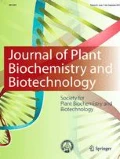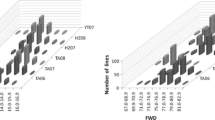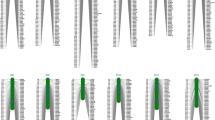Abstract
A recombinant inbred line (RIL) population derived from the cross between Pusa1266 (a new plant type) with Jaya (a popular indica rice variety) was used for mapping QTL associated with grain physico-chemical and cooking quality traits in rice. A total of 310 recombinant inbred lines were evaluated for nine grain physico-chemical and cooking quality traits at two locations in India, during Kharif 2007. A linkage map based on 135 molecular markers was developed and a total of 22 QTL associated with seven traits, namely brown rice percentage, milled rice percentage, kernel length before cooking, kernel breadth before cooking, length/breadth ratio, kernel length after cooking and kernel breadth after cooking on seven different chromosomes were identified by composite interval mapping. Pusa1266 allele contributed positively at 14 loci whereas Jaya contributed at 8 loci. Nine QTL influencing five different traits were identified with an R2 > 10%. A marker interval RM18222–HvSSR05-39 on chromosome 5 influencing two traits (qKBBC5-1, qLBR5-1) across the locations was identified. This locus can be used for fine mapping and identification of the candidate gene for these traits.


Similar content being viewed by others
Abbreviations
- RIL:
-
Recombinant inbred line
- QTL:
-
Quantitative trait loci
- BR:
-
Brown rice percentage
- MR:
-
Milled rice percentage
- KLBC:
-
Kernel length before cooking
- KBBC:
-
Kernel breadth before cooking
- LBR:
-
Length/breadth ratio
- SSR:
-
Simple sequence repeat
References
Aluko G, Martinez C, Tohme J, Castano C, Bergman C, Oard JH (2004) QTL mapping of grain quality traits from the interspecific cross Oryza sativa x O. glaberrima. Theor Appl Genet 109:630–639
Anonymous (2004) International year of rice. FAO (http://www.fao.org/rice2004/en/concept.htm).
Asins MJ (2002) Present and future of quantitative trait locus analysis in plant breeding. Plant breed 121:281–291
Ge XJ, Xing YZ, Xu CG, He YQ (2005) QTL analysis of cooked rice grain elongation, volume expansion, and water absorption using a recombinant inbred population. Plant Breed 124:121–126
Govindaraj P, Vinod KK, Arumugachamy S, Maheswaran M (2009) Analysing genetic control of cooked grain traits and gelatinization temperature in a double haploid population of rice by quantitative trait loci mapping. Euphytica 166:165–176
Heda GD, Reddy GM (1986) Studies on inheritance of amylose content and gelatinization temperature in rice. Genet Agr 40:1–8
Jennings PR, Coffman WR, Kauffman HE (1979) Grain quality. In: Rice improvements. Intl. Rice Res. Inst., Los Banos, Laguna, Philippines, pp 101–120
Juliano BO (1971) A simplified assay for milled rice amylose. Cereal Sci Today 16:334–338
Lander ES, Green P, Abrahamson J, Barlow A, Daley M (1987) MAPMAKER: an interactive computer package for constructing primary genetic linkage maps of experimental and natural populations. Genomics 1:174–181
Littell RC, Freund RJ, Spector PC (1991) SAS system for linear models, 3rd edn. SAS Institute Inc., Cary
Little RR, Hilder GB, Dawson EH (1958) Differential effect of dilute alkali on 25 varieties of milled white rice. Cereal Chem 35:111–126
Lou J, Chen L, Yue G, Lou Q, Mei H, Xiong L, Luo L (2009) QTL mapping of grain quality traits in rice. J Cereal Sci 50:145–151
McCouch SR, Doerge RW (1995) QTL mapping in rice. Trends Genet 11:482–487
McCouch SR, Cho YG, Yano M, Paul EM, Blinstrub M, Morishima H, Kinoshita T (1997) Report on QTL nomenclature. Rice Genet Newsl 14:11–13
McCouch SR, Teytelman L, Xu Y et al (2002) Development and mapping of 2240 new SSR markers for rice (Oryza sativa). DNA Res 9:199–207
Mester DI, Ronin YI, Hu Y, Nevo E, Korol A (2003) Efficient multipoint mapping: Making use of dominant repulsion-phase markers. Theor Appl Genet 107:1102–1112
Murray MG, Thompson WF (1980) Rapid isolation of high molecular weight plant DNA. Nucleic Acid Res 8:4321–4325
Parida SK, Dalal V, Singh AK, Singh NK, Mohapatra T (2009) Genic non-coding microsatellites in the rice genome: characterization, marker design and use in assessing genetic and evolutionary relationships among domesticated groups. BMC Genomics 10:140
Qiao Y, Jiang W, MdL R, Chu SH, Piao R, Han L, Koh HJ (2008) Comparison of molecular linkage maps and QTLs for morphological traits in two reciprocal backcross populations of rice. Mol Cells 25(3):417–427
Rabiei B, Valizadeh M, Ghareyazie B, Moghaddam M, Ali AJ (2004) Identification of QTLs for rice grain size and shape of Iranian cultivars using SSR markers. Euphytica 137:325–332
Redona ED, Mackill DJ (1998) Quantitative trait locus analysis for rice panicle and grain characteristics. Theor Appl Genet 96:957–963
Septiningsih EM, Trijatmiko KR, Moeljopawiro S, McCouch SR (2003) Identification of quantitative trait loci for grain quality in an advanced backcross population derived from the Oryza sativa variety IR64 and the wild relative O. rufipogon. Theor Appl Genet 107:1433–1441
Shobharani N, Madhav SM, Pandey MK et al (2008) Genetics and molecular approaches for improvement of grain quality in rice. Indian J Crop Sci 3(1):1–14
Singh H, Deshmukh RK, Singh A et al (2009) Highly variable SSR markers suitable for rice genotyping using agarose gels. Mol Breed 25:359–364
Tan YF, Xing YZ, Li JX, Yu SB, Xu CG, Zhang QF (2000) Genetic bases of appearance quality of rice grains in Shanyou 63, an elite rice hybrid. Theor Appl Genet 101:823–829
Tanksley SD (1993) Mapping polygenes. Annu Rev Genet 27:205–233
Temnykh S, Park WD, Ayres N et al (2000) Mapping and genome organization of microsatellite sequences in rice (Oryza sativa L.). Theor Appl Genet 100:698–712
Wang LQ, Liu WJ, Xu Y, He YQ, Luo LJ, Xing YZ, Xu CG, Zhang QF (2007) Genetic basis of 17 traits and viscosity parameters characterizing the eating and cooking quality of rice grain. Theor Appl Genet 115:463–476
Yoshida S, Ikegami M, Kuze J, Sawada K, Hashimoto Z, Ishii T, Nakamura C, Kamijima O (2002) QTL analysis for plant and grain characters of sake-brewing rice using a double haploid population. Breeding Sci 52:309–317
Zheng X, Wu JG, Lou XY, Xu HM, Shi CH (2008) The QTL analysis on maternal and endosperm genome and their environmental interactions for characters of cooking quality in rice (Oryza sativa L.). Theor Appl Genet 116:335–342
Acknowledgments
The study was financially supported by grants from Indian Council of Agricultural Research, India. The work presented has been submitted as a part of the thesis to Banasthali University, Rajasthan, India by the first author.
Author information
Authors and Affiliations
Corresponding author
Rights and permissions
About this article
Cite this article
Guleria, S., Sharma, V., Marathi, B. et al. Molecular mapping of grain physico-chemical and cooking quality traits using recombinant inbred lines in rice (Oryza sativa L.). J. Plant Biochem. Biotechnol. 21, 1–10 (2012). https://doi.org/10.1007/s13562-011-0064-3
Received:
Accepted:
Published:
Issue Date:
DOI: https://doi.org/10.1007/s13562-011-0064-3




